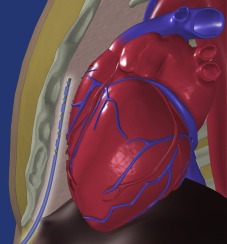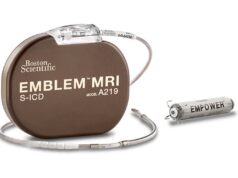 A study on substernal pacing acute clinical evaluation (SPACE) by Darius Sholevar (Our Lady of Lourdes Medical Center, Camden, USA) et al published in the Heart Rhythm journal has investigated the feasibility of extravascular pacing using a novel substernal electrode configuration. The research suggests such pacing can provide an alternative treatment to existing non-transvenous defibrillation, which does not offer antitachycardia pacing (ATP).
A study on substernal pacing acute clinical evaluation (SPACE) by Darius Sholevar (Our Lady of Lourdes Medical Center, Camden, USA) et al published in the Heart Rhythm journal has investigated the feasibility of extravascular pacing using a novel substernal electrode configuration. The research suggests such pacing can provide an alternative treatment to existing non-transvenous defibrillation, which does not offer antitachycardia pacing (ATP).
The prospective, non-randomised, multicentre, acute feasibility study investigated a novel cardiac pacing approach in which a catheter was implanted in the extravascular substernal space of 26 patients undergoing cardiac procedures at centres in the USA and Canada. The procedures performed included subcutaneous implantable cardioverter-defibrillator (S-ICD) implantations and cardiac surgery with sternotomy.
Decapolar catheter placement was successful in all patients, with a mean catheter placement time of 11.7 (±10.1) minutes. For patients with pacing capture, the average pacing threshold across all vectors when using a long pulse width of 10 milliseconds was 7.3±4.2 milliamps (5.8±4.4 volts). Sholevar et al write, “In transvenous ICDs, ATP is generally performed at an output of 8 volts, which is typically the maximum pacing voltage output of commercially available ICDs. As such, the average substernal pacing thresholds observed in the SPACE study were within the output settings typically used for delivering ATP in transvenous ICDs, though technology to generate a longer pulse width, such as utilised in the SPACE study, might be necessary to keep pacing thresholds low.” Feasibility of substernal extravascular pacing was demonstrated, particularly when using a widely spaced bipolar electrode configuration.
The investigators observed inconsistent ventricular capture in eight patients with suboptimal catheter positioning, and argue that pacing capture may have been achieved with optimal positioning and more careful control of air ingression into the substernal space. Pacing rate was set to 20 beats per minute (BPM) above intrinsic and pacing capture defined as three consecutive beats of capture. “A lengthier protocol might have allowed more thorough characterisation of pacing performance”, Sholevar et al note, adding that the rapid protocol execution was selected due to the lack of benefit for the patients from the study, in order to minimise experimental study duration.
The study used market-released catheters for pacing, a custom-designed lead specifically intended for use in extravascular substernal pacing would likely increase the success rate in pacing capture, the investigators suggest.
It was the first reported human clinical study of a novel extravascular substernal pacing approach using a minimally invasive subxiphoid implant, demonstrating “a new approach to pacing while avoiding hardware implantation within the heart of vasculature.” Sholevar et al concluded by highlighting the potential for substernal electrode configuration to provide pacing using “a simple, single implant procedure.”









